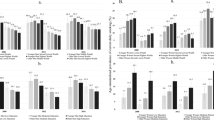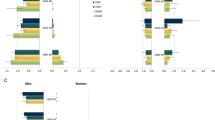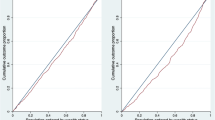Abstract
Objectives
To assess whether socioeconomic inequalities in smoking in five regions across in Turkey have the same pattern as observed in southern Europe.
Methods
Cross-sectional data of the World Health Survey 2002 from Turkey were analyzed (5,951 women and 4,456 men) to evaluate the association of smoking with wealth and education. Age-standardized prevalence rates and odds ratios were calculated separately by sex, region and age groups.
Results
Smoking prevalence was 16.7 % for women and 51.4 % for men. Smoking risk was increased in higher wealth and education groups among women in all regions and for both younger and older generations. In the East, Middle and Black Sea regions this female pattern was most pronounced. For men, smoking was less prevalent in the two highest wealth groups. Unlike among women, socioeconomic differences in smoking were approximately equally large in all regions.
Conclusions
Patterns of inequalities in smoking across the five regions strongly resemble those observed in southern Europe. This fits the patterns predicted by the smoking epidemic model. Particular attention should be given to highly educated women, who may perceive smoking as a symbol of modernity, emancipation and independence.

Similar content being viewed by others
References
Afifi RA, Nakkash RT, Khawaja M (2010) Social capital, women’s autonomy and smoking among married women in low-income urban neighborhoods of Beirut, Lebanon. Women’s Health Issues 20:156–167
Amos A, Haglund M (2000) From social taboo to ‘‘torch of freedom’’: the marketing of cigarettes to women. Tob Control 9:3–8
Anderson SJ, Glantz SA, Ling PM (2005) Emotions for sale: cigarette advertising and women’s psychosocial needs. Tob Control 14:127–135
Çan G, Çakırbay H, Topbaş M et al (2007) Doğu Karadeniz Bölgesi’nde sigara içme prevalansı. Tüberküloz ve Toraks Dergisi 55:141–147
Cavelaars AEJM, Kunst AE, Geurts JJ et al (2000) Educational differences in smoking: International comparisons. BMJ 320:1102–1107
Dincer B, Ozaslan M, Kavasoglu T (2003) Socioeconomic development order of provinces and regions in Turkey. State Planning Organization, Ankara
Ergin I, Hassoy H, Kunst AE (2012) Socioeconomic inequalities in overweight among adults in Turkey: a regional evaluation. Public Health Nutr 15:58–66
Erler MY, Edinsel K (2011) Tobacco production in Samsun (1788–1919). J Intern Soc Res 4:230–247
General directorate on the status of women (2008) Policy document women and education, Ankara http://www.kadininstatusu.gov.tr/upload/mce/eski_site/Pdf/egitim_ingilizce.pdf. Accessed 15 June 2012
Giskes K, Kunst AE, Benach J et al (2005) Trends in smoking behaviour between 1985 and 2000 in nine European countries by education. J Epidemiol Community Health 59:395–401
Global Adult Tobacco Survey (GATS) (2010) Global Adult Tobacco Survey Turkey Report, Ministry of Health http://www.who.int/tobacco/surveillance/en_tfi_gats_turkey_2009.pdf. Accessed 11 June 2012
Helasoja VV, Lahelma E, Prättälä RS et al (2006) Determinants of daily smoking in Estonia, Latvia, Lithuania, and Finland in 1994–2002. Scand J Public Health 34:353–362
Hitchman SC, Fong GT (2011) Gender empowerment and female-to-male smoking prevalence ratios. Bull World Health Organ 89:195–202
Hosseinpoor AR, Parker LA, Tursan d’Espaignet E, Chatterji S (2012) Socioeconomic inequality in smoking in low-income and middle-income countries. Results from the World Health Survey. PLoS ONE 7(8): e42843
Huisman M, Kunst AE, Mackenbach JP (2005a) Inequalities in the prevalence of smoking in the European Union: comparing education and income. Prev Med 40:756–764
Huisman M, Kunst AE, Mackenbach JP (2005b) Educational inequalities in smoking among men and women aged 16 years and older in 11 European countries. Tob Control 14:106–113
Leinsalu M, Tekkel M, Kunst AE (2007) Social determinants of ever initiating smoking differ from those of quitting: a cross-sectional study in Estonia. Eur J Public Health 17:572–578
Leinsalu M, Kaposvári C, Kunst AE (2011) Is income or employment a stronger predictor of smoking than education in economically less developed countries? A cross-sectional study in Hungary. BMC Public Health 11:97
Lopez AD, Collishaw NE, Piha T (1994) A descriptive model of the cigarette epidemic in developed countries. Tob Control 3:242–247
Mckay J, Amos A (2003) Women and tobacco. Respirology 8:123–130
Murphy NT, Price CJ (1988) The influence of self-esteem, parental smoking and living in a tobacco production region on adolescent smoking behaviours. J Sch Health 58:401–405
Ökten Ş (2009) Gender and power: the system of gender in South eastern Anatolia. J Intern Soc Res 2:302–312
Patrick DL, Cheadle A, Thompson DC et al (1994) The validity of self-reported smoking: a review and meta-analysis. Am J Public Health 84:1086–1093
Pomerleau J, Gilmore A, McKee M et al (2004) Determinants of smoking in eight countries of the former Soviet Union: results from the living conditions, lifestyles and health study. Addiction 99:1577–1585
Pudule I, Grinberga D, Kadziauskiene K et al (1999) Patterns of smoking in the Baltic Republics. J Epidemiol Community Health 53:277–282
Rebagliato M (2002) Validation of self reported smoking. J Epidemiol Community Health 56:163–164
Schaap MM, Kunst AE (2009) Monitoring of socio-economic inequalities in smoking: learning from the experiences of recent scientific studies. Public Health 123:103–109
Schaap MM, Van Agt HME, Kunst AE (2008) Identification of socioeconomic groups at increased risk for smoking in European countries: looking beyond educational level. Nicotine Tob Res 10:359–369
Schaap MM, Kunst AE, Leinsalu M et al (2009) Female ever-smoking, education, emancipation and economic development in 19 European countries. Soc Sci Med 68:1271–1278
Sozmen K, Baydur H, Simsek H, Unal B (2012) Decomposing socioeconomic inequalities in self assessed health in Turkey. Intern J Equity Health 11:73
Stronks K, van de Mheen HD, Mackenbach JP (1998) A higher prevalence of health problems in low income groups: does it reflect relative deprivation? J Epidemiol Community Health 52:548–557
Studts JL, Ghate SR, Gill JL et al (2006) Validity of self-reported smoking status among participants in a lung cancer screening trial. Cancer Epidemiol Biomarkers Prev 15:1825–1828
Suadicani P, Hein HO, Gyntelberg F (1994) Serum validated tobacco use and social inequalities in risk of ischaemic heart disease. Int J Epidemiol 23:293–300
Thrasher JF, Niederdeppe J, Farrelly MC et al (2004) The impact of anti-tobacco industry prevention messages in tobacco producing regions: evidence from the US truth campaign. Tob Control 13:283–288
Turkish Statistical Institute (2003) Database for population census 2000 population statistics. www.tuik.gov.tr/IcerikGetir.do?istab_id=158. Accessed 20 July 2010
Turkish Statistical Institute (2011) Women in Statistics 2011, Publication no: 3660 www.tuik.gov.tr/IcerikGetir.do?istab_id=238. Accessed 15 November 2011
Van Loon AJ, Tijhuis M, Picavet HS et al (2003) Survey non-response in the Netherlands: effects on prevalence estimates and associations. Ann Epidemiol 13:105–110
Vartiainen E, Seppälä T, Lilsunde P et al (2002) Validation of self reported smoking by serum cotinine measurement in a community-based study. J Epidemiol Community Health 56:167–170
Vasankari T, Jousilahti P, Knekt P et al (2011) Serum cotinine predicts bronchial obstruction regardless of self-reported smoking history. Scand J Public Health 39:547–552
Wagenknecht LE, Burke GL, Perkins LL et al (1992) Misclassification of smoking status in the CARDIA study: a comparison of self-report with serum cotinine levels. Am J Public Health 82:33–36
World Health Organization (1998) Guidelines for controlling and monitoring the tobacco epidemic, Geneva
World Health Survey (2002) Sampling Guidelines for Participating Countries. Switzerland, Geneva
World Health Survey Report of Turkey (2012) http://www.who.int/healthinfo/survey/whstur-turkey.pdf. Accessed 20 September 2012
Yürekli A, Önder Z, Elibol M et al (2010) The Economics of Tobacco Control and Tobacco Taxation: Challenges & Opportunities for a Tobacco Free Turkey. http://global.tobaccofreekids.org/files/pdfs/en/Turkey_Tobacco_Economics_en.pdf. Accessed 10 November 2011
Conflict of interest
None declared.
Author information
Authors and Affiliations
Corresponding author
Rights and permissions
About this article
Cite this article
Hassoy, H., Ergin, I. & Kunst, A.E. Socioeconomic inequalities in current daily smoking in five Turkish regions. Int J Public Health 59, 251–260 (2014). https://doi.org/10.1007/s00038-013-0476-z
Received:
Revised:
Accepted:
Published:
Issue Date:
DOI: https://doi.org/10.1007/s00038-013-0476-z




